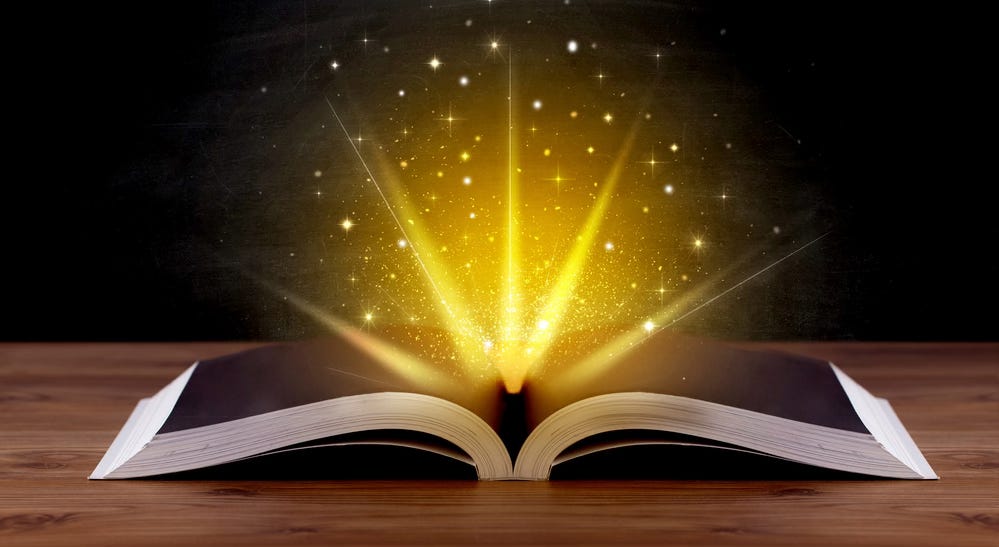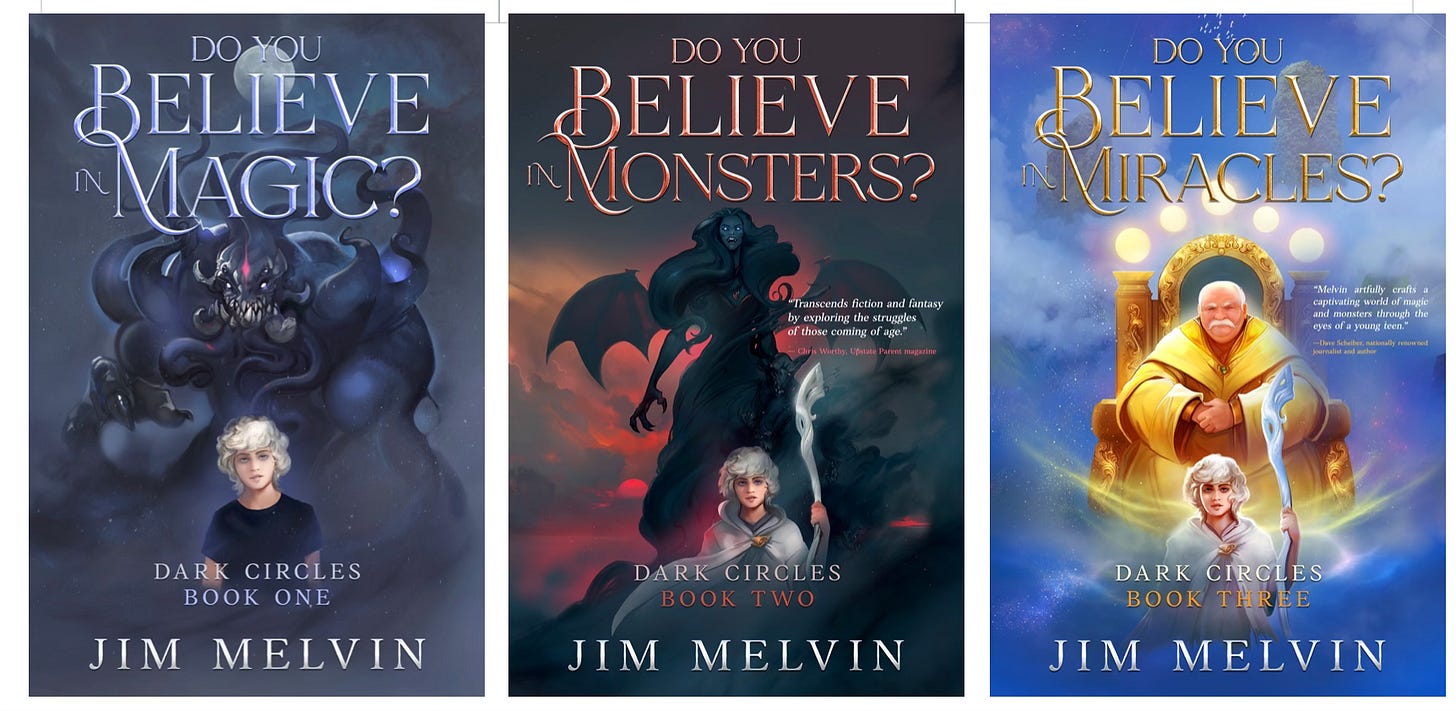Journey with me through a magical world (Chapter 24 | Book 2)
The 25th excerpt (including prologue) from "Do You Believe in Monsters?"
Every Friday, I’ll send you the opening paragraphs from a chapter of Do You Believe in Monsters?. Then I’ll break down the excerpt with comments about context, themes, and conflict. Finally, I’ll include writing tips.
DARK CIRCLES (teen fantasy adventure series)
Book 1: Do You Believe in Magic? (debuted May 25)
Book 2: Do You Believe in Monsters? (debuted Oct. 30)
Book 3: Do You Believe in Miracles? (debuted April 21, 2024)
Though my series is appropriate for ages 13 and older, I’m finding that readers younger than 13 — and many who are a lot older than 13 — are enjoying it.
Here is a brief synopsis of book 2: When Charlie Magus enters a fantastical world hidden deep in the forest, his life is turned upside down. The timid 13-year-old transforms into a powerful wizard wielding formidable powers.
Below are the opening paragraphs of Chapter 24 of book 2. My author’s breakdown follows this short segment.
Context: The Yellow One, an ancient sorcerer of unknown origin, plans the destruction of the Niddukk.
CHAPTER 24 | THE YELLOW ONE
The Yellow One had been around for a long time.
To him, a year was a century, a century a millennium. Surely there were older beings than him somewhere. But the universe was huge beyond comprehension, and in the places the Yellow One had been, there were none older than him in anything that resembled human form. He was around even before the Niddukk first appeared.
But the Niddukk’s rapid rise had forced the Yellow One to refocus his attention. And for the past thousand years, he had become the Niddukk’s most lethal adversary, a festering thorn in the monster’s side. However, the Niddukk’s power continued to increase, while the Yellow One had grown old and faded. Destroying the Niddukk was his final goal. But with every passing moment, that goal became less attainable.
Out of necessity, the Yellow One—author of the ancient prophesies—devised an elaborate plan. He fashioned a bloodline that extended through a hundred generations. He nudged it and nurtured it until he could give rise to a young human with the physical and mental capacity to fully absorb his magic, not just tolerate a portion of it. This boy now had all the powers of the Yellow One plus one more asset: the fervor of youth.
In the ancient tongue, the Yellow One’s creation became known as the Setavanna-Kesakalyana, the boy with white hair and blue eyes. White for honor, enlightenment, and mercy. Blue for peace, wisdom, and empathy.
All attributes the Niddukk notably lacked.
But there was more. Not even the Setavanna-Kesakalyana could defeat the Niddukk by himself, so the Yellow One nurtured other bloodlines that matured in unison. A warrior. A goliath. And a translator.
Magic spells had created the Niddukk’s portals. But like all spells, they could be undone if a being of power spoke the correct words. And if the portals were undone, the Niddukk would be trapped in Pacchann forever.
The Yellow One was eager to move on to his next plane of existence. But he had one final task.
Trap the Niddukk in Pacchann and then destroy him.
Finally, he had the means. The pieces were in place.
But there was still a lot left to do.
And nothing was guaranteed.
End of excerpt.
Themes: Machinations; magic; culmination.
Between the lines: Like a seed planted in shallow soil, the incorporation of mystery into a novel’s narrative begins on the surface and then slowly creeps down and out, resulting in a compelling blend of tension and intrigue. Writers feed the roots of mystery by strategically unveiling the secret parts. Reveal too much too quickly, and the tension dissolves. Reveal too little too slowly, and the tension loses its oomph.
The trick, of course, is pinpointing the timeliest moments to disclose the pieces of the puzzle.
Writing tips: I’ve been reading a lot of books lately by “no-names” and “newcomers.” I define a no-name as someone who isn’t famous and a newcomer as someone who has recently published his or her first book. I’m not a newcomer, but in terms of sales and recognition, I fit into the no-name category. There’s no shame in this. The vast majority of writers are no-names or newcomers.
I’ve been a professional writer (journalist, communicator, novelist) for forty-plus years, so I’ve been around for quite awhile. The authors who most influenced my novels have also been around awhile: J.R.R. Tolkien, George R.R. Martin, Stephen Donaldson, Anne McCaffrey, Steven Erikson, Ursula K. Le Guin, Stephen King, Terry Brooks, Neil Gaiman, Robert Jordan, Robert Howard, etc.
When comparing books that were written more than a decade ago with ones that have come out in the past five years or so, one thing stands out to me: Many of today’s bestselling novels — especially those that are self-published — are notably shallow and excessively linear. They start at Point A and rush madly to Point B, followed by The End. The characters themselves hardly seem to matter. It’s all about plot and action, with little room for depth and emotion. I see very little character development, symbolism, allegory, irony, foreshadowing, et al. To be blunt, the books are dumbed-down. And I don’t know which is more to blame: the writers’ abilities or the readers’ attention spans.
This is not to say that all of today’s books are like this. Of course not. There are fabulous works coming out every day that are every bit as good as anything previously produced. But it feels to me that the percentage of dumbed-down novels is growing rather alarmingly.
Writers nowadays are forced to choose to either write from the heart using all their skills, which risks a potential reduction in sales; or dumb it down with the hope of tapping into an increasingly large audience that seems to prefer it that way. I vote for the former. How about you?
Past episodes of Book 2 (Do You Believe in Monsters?)
Prologue | Chapter 1 | Chapter 2 | Chapter 3 | Chapter 4 | Chapter 5 | Chapter 6 | Chapter 7 | Chapter 8 | Chapter 9 | Chapter 10 | Chapter 11 | Chapter 12 | Chapter 13 | Chapter 14 | Chapter 15 | Chapter 16 | Chapter 17 | Chapter 18 | Chapter 19 | Chapter 20 | Chapter 21 | Chapter 22 | Chapter 23
Past episodes of Book 1 (Do You Believe in Magic?)
Prologue | Chapter 1 | Chapter 2 | Chapter 3 | Chapter 4 | Chapter 5 | Chapter 6 | Chapter 7 | Chapter 8 | Chapter 9 | Chapter 10 | Chapter 11 | Chapter 12 | Chapter 13 | Chapter 14 | Chapter 15 | Chapter 16 | Chapter 17 | Epilogue
Promotional notes
Hi everyone!
I wrote the first words of Do You Believe in Magic? in February 2023. Fourteen months later, the epic saga is complete. Do You Believe in Miracles? made its debut on April 21.
Dark Circles is a teen fantasy adventure series appropriate for ages 13 and older, though readers as young as 10 and as old as 80 have told me they loved it — sort of like the Harry Potter series.
DARK CIRCLES (teen fantasy adventure series)
Book 1: Do You Believe in Magic? (debuted May 25, 2023)
Book 2: Do You Believe in Monsters? (debuted Oct. 30, 2023)
Book 3: Do You Believe in Miracles? (debuted April 21, 2024)
All three books of the series are now available in four formats: ebook, paperback, hardcover, and audiobook.
This heartfelt coming-of-age series has won multiple awards:
First-place winner in the Firebird Book Award contest in Fantasy.
First-place winner in Firebird in Coming of Age.
Second-place winner in Firebird in Action and Adventure.
Gold winner in the International Impact Book Awards contest in Fantasy.
Gold winner of the Literary Titan Book Award in Fantasy.
Gold winner of The Bookfest Award contest in Teen Action and Adventure.
Silver winner in Bookfest in Fantasy Series.
All told, more than 17,000 copies of books 1-3 have been purchased, with an additional 50,000 pages read on Kindle Edition Normalized Pages (KENP). Like all self-published authors, I’m still hoping for more ratings and reviews.





Our soporific society mass-produces dumbing-down.
I'll vote for the former, also. I think it's the same with contemporary music.